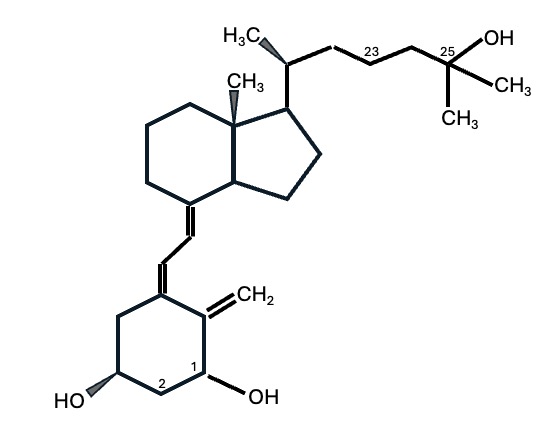Calcitriol
By Jens Allmer
The name Calcitriol (aka vitamin D) refers to a hormone that is produced via hydroxylation of Calcifediol in the human liver. Calcitriol is typically bound by the D-binding protein (DBP) but has a lower affinity DBP than Calcifediol but higher than Cholecalciferol. Calcitriol is the active form of the hormone and facilitates calcium uptake among a myriad of other functions, such as immune system-related ones.
 Chemical structure of Calcitriol
Chemical structure of Calcitriol
Chemical structure of Calcitriol. Cholecalciferol is only hydroxylated in position three, whereas Calcifediol is also hydroxylated in position 25. Calcitriol has three hydroxyl groups attached (positions 1, 3, and 25).
Calcitriol is produced by hydroxylation of Calcifediol in the kidney. Since Calcitriol is the active form of the hormone, its levels must be controlled. There is a self-regulation that down-regulates Calcitriol levels when they become high. Calcitriol is also under the control of the Parathyroid hormone.
Calcitriol is not a good marker for vitamin D sufficiency since it can be in a normal range while overall storage (Calcifediol) is low. However, it is important to confirm that Calcitriol can be produced or it must be supplemented as in kidney disease where the conversion to Calcitriol may be hampered.
| pg/ml | pmol/L | |
| Reference range | 20-70 | 48-168 |
Please note, that the ranges are in picogram and pico mole unlike Calcifediol which has much higher levels in the nanogram and nano mole range.
The much lower amount of Calcitriol compared to Calcifediol supports the idea that Calcifediol acts as storage and is converted to Calcitriol when needed. Diseases such as sarcoidosis and chronic kidney disease (CKD) disturb this process and lead to too much (/health/sarcoidosis) or too little (CKD) conversion.
